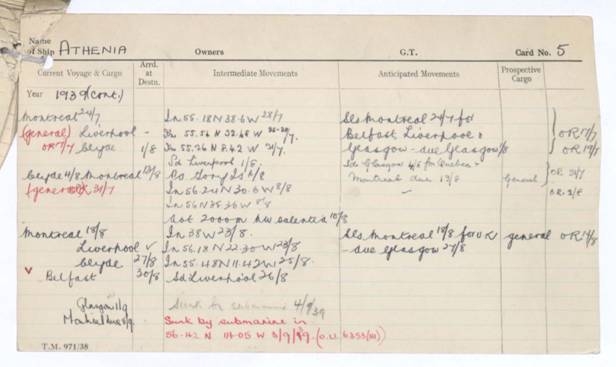
How to look for records of... Merchant Navy ships’ records: movement cards 1939-1945
How can I view the records covered in this guide?
How many are online?
- All
What are these records?
These records are digitised cards recording the movements of British and Allied merchant ships during the Second World War.
In 1939 the Admiralty instructed the Board of Trade, for reasons of security, to prevent masters of merchant vessels from using ships’ logs or crew lists and agreements to record destinations or ports of call. However, it was still important to record the movements of merchant vessels and so the Registrar General of Shipping and Seamen established this series of cards, now held by The National Archives in series BT 389.
What information do the records contain?
The cards record the movements of both British-registered and Allied vessels engaged in the war effort. They do not contain details of any passengers or crew. Each set of cards records:
- name of the ship
- former name/s of the ship (if any)
- size (tonnage) of ship
- to whom ship was registered
- ship’s destination
- date of arrival at destination
- sometimes ports of call
- any cargo carried on board
The cards also show if the ship was torpedoed, mined, damaged or sunk.
What do the records look like?
Unfortunately, many cards contain a lot of abbreviations and there is no known key for them.
Below is the last movement card for the SS Athenia. On 1 September 1939 this passenger liner set sail from Glasgow with over 1400 passengers and crew aboard. She was torpedoed and shelled by the German U-boat U30 without warning, becoming the first merchant vessel casualty of the Second World War.
In the top left corner of the record is the ship’s name. If a ship had a former name this would be written in brackets. Owners and gross tonnage (G.T.) are also recorded at the top of the card.From left to right, the six columns on the card will tell you:
- the year, current voyage and cargo
- the date of arrival at the destination
- the day by day movements of the ship (in Athenia’s case the final entry records her sinking)
- anticipated movements, i.e. the intended destination
- details of the cargo expected to be collected at the next port of call
- the initials of the clerk making the entry and the date it was made
How do I search the records?
You can search the records in Discovery, our catalogue, by using the search box below.
Why can’t I find what I’m looking for?
You may be searching for a vessel for which these cards were never used. This collection records the movements of ships ordinarily engaged in foreign going trade. It does not, however, include:
- vessels normally employed in home trade
- vessels requisitioned for military service
- small craft
You may be searching for a ship using a former name. Not all changes in ships’ names are logged on the cards and in such cases it will be necessary to obtain the ship’s official number (not usually recorded on the cards) and check against that number for all possible name changes. The Miramar ship index can be useful for obtaining this information.
You may be searching for a ship on dates before or after movement cards were in use on that vessel. The card entries do not all start or end at the same time. If there is no entry on a card for the early or later part of the war, check the crew lists and agreements in series BT 99, BT 100, BT 380 or BT 381 which may hold further details.
